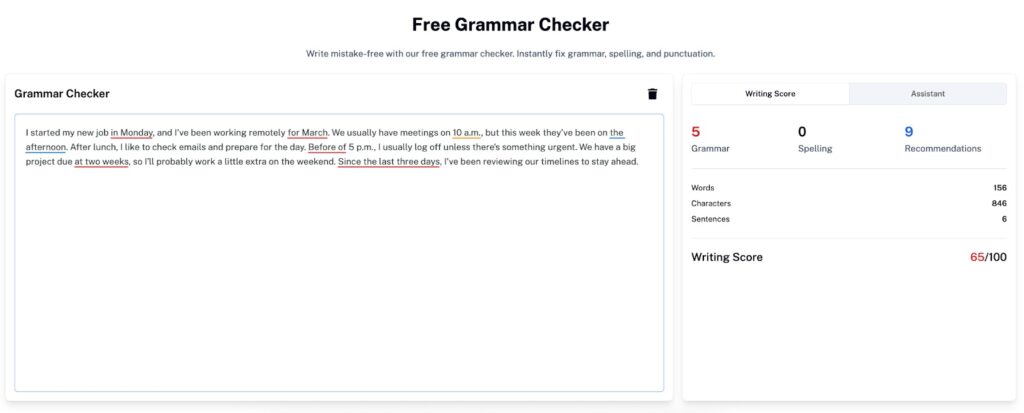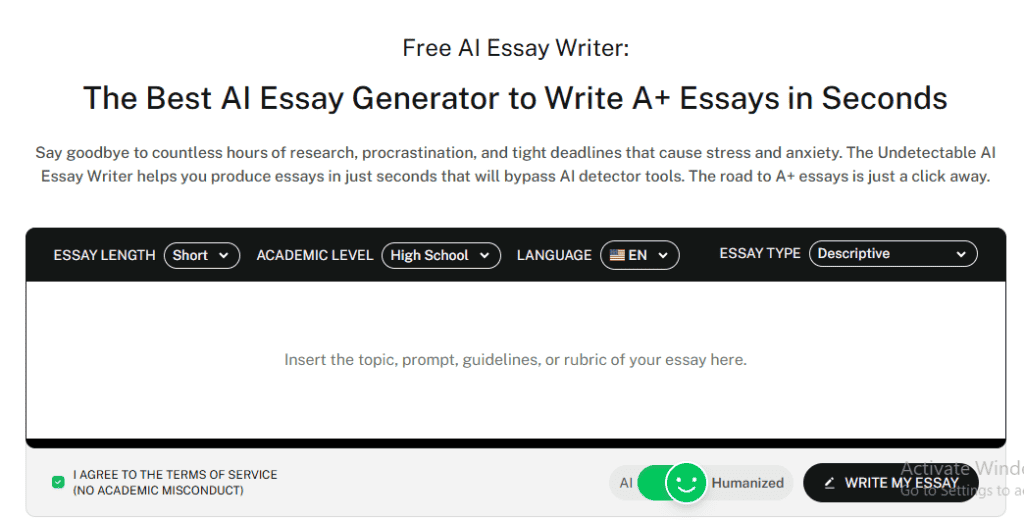You’re writing a typical email to a colleague when suddenly you have a brain fart. Is it “I’ll see you at Monday?” or “on Monday?”
Prepositions have grammar rules that could easily sneak up on you.
They’re one of the eight parts of speech, showing the relationship between a noun (or pronoun) and something else in the sentence, like time, place, direction, manner, or cause, which is why there are also different types of prepositions.
Little details like these make the English language both powerful and complicated at the same time.
If “in”, “on”, and “at” confuse you, this is your guide.
You’ll be learning about prepositions of time, how to use them correctly, and examples used in everyday and formal sentences.
Key Takeaways
- Prepositions of time aim to describe when something happens, connecting to time-related nouns like days, dates, and time periods to clarify your sentences.
- “In,” “on,” and “at” are the most common prepositions of time, where “in” is used for spans of time, “on” for more specific days and dates, and “at” for exact times.
- Prepositions of time are used across everyday and professional settings, and beginners can benefit from learning them early on.
What Are Prepositions of Time?
Prepositions of time are words you use to communicate when something happens.
These help anchor events in a timeline, like whether you’re specifying a date, a period, or an exact moment.
For example, if you say “The meeting is Monday,” it sounds off, even though it’s still grammatically correct. Plus, it leaves out specific details.


Never Worry About AI Detecting Your Texts Again. Undetectable AI Can Help You:
- Make your AI assisted writing appear human-like.
- Bypass all major AI detection tools with just one click.
- Use AI safely and confidently in school and work.
But when you say “The meeting is on Monday at 2 p.m.,” then you make it much clearer.
By adding prepositions, you also didn’t need to add another sentence to provide more information.
So, instead of giving vague descriptions, you can use prepositions of time to specify exactly when actions take place.
Definition and Core Function
A preposition’s main job is to show the relationships between words in a sentence.
Think of them as bridges that help the reader or listener understand when something happened, where it took place, and how it was done.
Prepositions of time specifically answer questions related to “when,” “how long,” or “at what point.” When it’s part of a prepositional phrase, it works as a unit to provide more important details.
You combine prepositions with nouns or time expressions to set clear timeframes.
When combined, it should look like this:
- Preposition → in
- Prepositional phrase → in December
- Complete sentence → The whole family’s going on vacation in December.
Time vs Place vs Direction Prepositions
Before we go deeper into prepositions of time, we want to specify how they differ from other prepositions.
Here’s how each of them compares:
- Prepositions of time: Describes when something happens. They’re often used with time-related nouns like dates, times, and periods.
Examples: on Friday, since last year, until tomorrow
- Prepositions of place: Answers the question where. They show the location of the subject in relation to another object.
Examples: under the bed, between the chairs, at the bus stop
- Prepositions of direction: Answers where to. Compared to prepositions of place that only state where something is, prepositions of direction indicate movement from one place to another.
Examples: toward the exit, across the street, through the tunnel

Struggling to figure out how a preposition is used? Some phrases can look quite similar but can mean completely different things.
Learning to spot the differences takes time, but you can use Undetectable AI’s Ask AI tool to get instant feedback whenever you’re unsure.
With the Ask AI tool, you get clear explanations and can also save your results so you can review them later.
It’s a simple yet effective way to build confidence as you learn.
The Big Three: At, On, In
When it comes to prepositions of time, “at”, “on,” and “in” are the most popular but also some of the most easily confused.
Here’s what set each of them apart.
How to Use “At”
You use at when you’re referring to a specific point in time. It’s the most specific among the three.
Here are specific instances you’d want to use “at.”
Specific Time:
- The party starts at 7 p.m.
- She usually wakes up at 6:30.
Holidays (without “day” or “morning” modifiers):
- We’re visiting family at Christmas.
- They traveled home at Easter.
Mealtimes:
- Let’s talk at lunch.
- We’ll be meeting at dinner.
How to Use “On”
If you want to be more specific but less than what “at” is used for, you can use “on.” It covers 24-hour periods or longer.
Here’s when “on” makes sense to use.
Specific Days:
- We have class on Thursday.
- She called me on my birthday.
Dates:
- The event is on August 10.
- I was born on July 28, 1998.
Weekends:
- We volunteer at the animal shelter on weekends.
- We’re going to hike on the weekend.
How to Use “In”
“In” is the most generous in terms of time span. It provides context, but it’s used when no precise date or time is needed.
Here’s when you can use “in.”
Months:
- The flowers bloom in April.
- She’s arriving in August.
Years:
- He was born in 2001.
- The law was passed in the late 19th century.
Parts of the Day:
- We’ll leave in the morning.
- I get lazy in the afternoon.
Long Periods:
- The project will be finished in two weeks.
- The project was completed in only three months.

Up for some practice? Try at your own pace with the Undetectable AI Grammar Checker.
Use the tool to spot errors in your choice of prepositions (or any grammar issue that sneaks in).
It flags problems in real time, so you can identify mistakes and learn as you write.
Other Common Prepositions of Time
While “in,” “on,” and “at” are the heavy-hitters, they’re far from being the only prepositions of time you can use.
These are some of the other prepositions to include in your grammar toolkit:
- Since: For things that still go on.
Example: I’ve been working here since 2023.
- For: Identifies a range of time.
Example: They’ve been away for a week.
- By: When you want to indicate a deadline.
Example: Finish your homework by 8 p.m.
- Until: For when something stops.
Example: I’ll watch a movie until you arrive.
- During: Indicates something is happening within a specific period.
Example: He fell asleep during class.
- From… to: Marks a beginning and an end.
Example: She’ll be working from Tuesdays to Saturdays.
With these additional prepositions, you can add more variety (and detail) to your sentences.

Sentence Examples Using Prepositions of Time
Proper English shouldn’t be reserved for professional or formal business settings.
It can be equally important even in your everyday conversations and writing. The more you practice in your daily life, the more natural it becomes.
Below are sentence examples that show how prepositions of time apply everywhere.
Everyday Contexts
Applying proper prepositions to everyday use avoids misunderstandings and makes things much clearer.
Here’s how it looks in real-life situations:
- School: You might get asked about classes and homework deadlines.
Example: The exam is on Friday.
- Work: Whether you’re working remotely or in the office, the workplace involves a lot of meetings and schedules to follow.
Example: Let’s have the meeting at 3 p.m.
- Events: Applies to whatever you’ll attend, like birthdays, anniversaries, concerts, and other celebrations.
Example: They’ll get married in September.
Academic and Formal Examples
When writing a paper or preparing a presentation in academic or professional settings, using prepositions of time properly can help clarify research details (where accuracy is key) and maintain a formal tone for communication.
Academic examples:
- The experiment began at 9 a.m. and ended at noon.
- The study took place over two semesters.
Formal examples:
- The software update was deployed in Q2 of 2024.
- The contract was signed at the start of the fiscal year.
ESL-Style Fill-in-the-Blank Sentences
Try filling in the blanks to practice how prepositions work. This is a no-pressure exercise.
It’s okay to make mistakes as you go.
- The store closes ____ 8 p.m.
- He always takes a nap ____ lunchtime.
- The flight landed ____ the evening.
- Her birthday is ____ November 11.
- The science fair will be held ____ Tuesday.
- The policy was revised ____ the early 2000s.
- We usually avoid traveling ____ the holidays.
- The museum was closed ____ noon but reopened later.
- Our professor held office hours ____ every Tuesday morning last month.
- The event was postponed ____ further notice.
No looking below until you’re finished!
Already done? Check how many you got right.
- At
- At
- In
- On
- On
- In
- During
- At
- On
- Until

If you’re looking to take your writing further, the Undetectable AI’s AI Essay Rewriter can help you polish your sentences on the fly.
It’s a great way to simplify complex sentences using prepositions or refine awkward phrasing you might have missed.
Get neat, professional results while learning along the way.
Common Mistakes and How to Fix Them
Even professionals find prepositions tricky at times. Take note of the most common errors when using prepositions of time and how you can correct them:
Mistake #1: Skipping the preposition entirely.
❌ We’ll meet Sunday.
✅ We’ll meet on Sunday.
While this can be accepted casually, it’s still grammatically incorrect. Always add the right preposition when it’s needed.
Mistake #2: Using prepositions redundantly.
❌ From since last year, she’s been working remotely.
✅ She’s been working remotely since last year.
Use only one based on what you mean.
Mistake #3: Confusing “over” and “during.”
❌ I got sick over the meeting.
✅ I got sick during the meeting.
“During” is used when something’s happening during the event. “Over” works better when talking about spans of time.
Mistake #4: Using “until” instead of “by” for deadlines.
❌ Submit your report until Friday.
✅ Submit your report by Friday.
“Until” works for continuous actions that end later. This differs from “by,” where an action has to finish before a particular time.
Mistake #5: Using “since” with a duration instead of a start time.
❌ I’ve stayed here since five years.
✅ I’ve stayed here for five years.
“Since” needs a starting point. Use “for” when stating a duration.

When used responsibly, AI works wonders in improving efficiency and learning. However, even minor help from AI tools can get flagged.
Use Undetectable’s Advanced AI Humanizer to smooth things out. This way, you can be sure that prepositions are used correctly and naturally, without losing your unique voice in writing.
Prepositions of Time in Questions and Negatives
Prepositions of time are just as important when used in both questions and negative sentences.
In questions, prepositions of time help you ask or clarify when something happens.
They appear before the time expression, like:
“Did you arrive on time?”
“Will you finish the report in three days?”
For negatives, the prepositions mark when something doesn’t happen.
For example:
“I wasn’t able to go to class in the morning.”
“The team didn’t arrive at the scheduled time.”

Prepositions of Time for ESL and Beginners
If English isn’t your first language, learning about prepositions can get overwhelming. “In,” “on,” and “at” are easy to memorize, but how you apply them isn’t always that obvious.
Here are some beginner tips when using prepositions of time:
- Start with the basics: Get the hang of using “in,” “on,” and “at” first. These can serve as your starting point for using the more complex ones.
- Notice the patterns: See how native speakers use prepositions. Watch a movie, read books, or listen to conversations. They’re used everywhere.
- Practice with examples: Start by writing short sentences before working your way up so you can better remember grammar rules.
- Try to visualize: As these prepositions deal with time, create a timeline or use a calendar to visualize precisely what the sentences mean.
Check out our AI Detector and Humanizer right in the widget below!
You’re “In” Time, “On” Point, and “At” Ease
Knowing how to use prepositions of time might seem relatively unimportant at first, but they’re an important step if you want to write and speak confidently in English.
With enough practice, you’ll stop second-guessing and start using them more naturally.
If you’re still unsure, that’s okay. Even the experts slip from time to time.
Need guidance on your way to fluency?
Undetectable AI has you covered. With its array of tools, you can instantly check your writing for lapses, simplify complex sentences, and practice your own pace.
Whether drafting a business presentation or studying for class, you can catch common mistakes and stay sharp with Undetectable AI.
